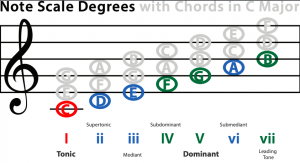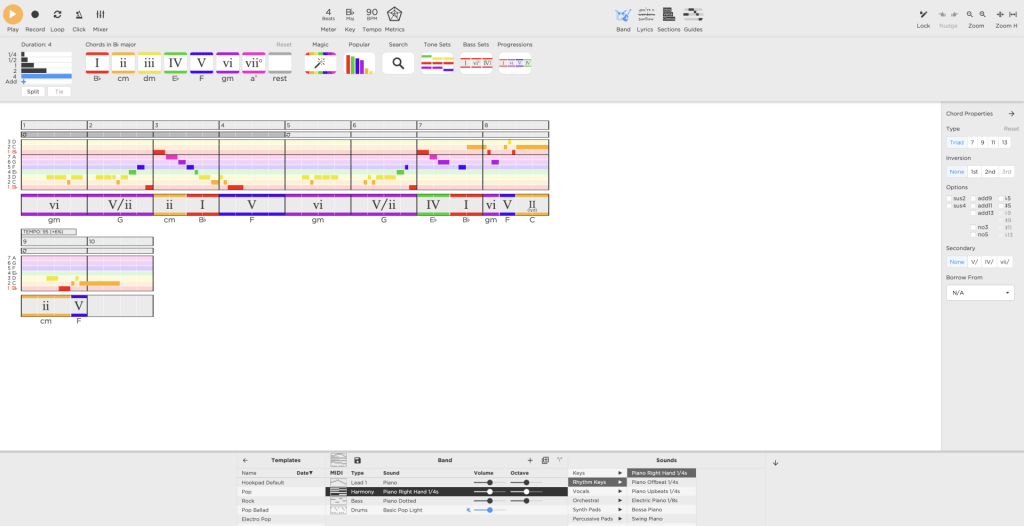
Summary
This project is a brief introduction to my introduction to music theory, via Hooktheory. I create and break down some basic melodies, and explore one of my favorite chord progressions in music.
My First HookTheory Chord Progression (Harmony)

- Watch this HookTheory Harmony Tutorial
- Make an 8-measure chord progression
- Place a screenshot of your 8-measure chords (harmony) from hookpad.hooktheory.com
- Link to a .mp3 file of your first HookTheory chord progression (harmony) that you exported from hookpad.hooktheory.com
- Write a brief reflection about this chord progression (harmony).
- What do you like about it?
- DELETE ALL OF MR. LE DUC’s INSTRUCTIONS AFTER COMPLETING THEM
Notes from Howard Goodall’s Harmony Video
| Cue | Notes |
Does a drone set the key? What, technically, is a melody? | A drone is a single, usually “droning” note you can sing any melody above. Harmony is two notes playing at the same time. The drone copies the melody – it is “parallel.” A Triad is when three notes play together There are hidden notes in a single note called harmonics. Humans can only really pick out three or four harmonics. Harmonics help build hierarchies in chords. Harmonics like the “colors” in white light; chords like those colors (red and blue) making yellow. A minor triad/chord is a chord where the middle note is a half-step lower. Polyphony is when you have many chords under the melody. Tonic-Dominant relationship (1 and 5) (C and G) (got too complicated, tried to absorb with just my brain for a bit) |
Summary: Music theory seems built like a pyramid, and a lot easier to learn than I initially thought. It makes sense; it’s just a lot. I feel like once I understand the rules, I’ll be okay.
Harmony Composition Terms and Definitions
- Harmony was not originally part of music until the middle ages and the renaissance
- Harmony sounds like it comes from some other plane of existence (to exaggerate a bit)
- Harmony in its simplest and oldest form in two notes playing at the same time
- A drone is a single note that you can sing any melody above. Bagpipes are an instrument that plays a drone.
- A drone is usually the tonic
- When people started to move the drone around, it was like the melody and the harmony were parallel lines. As the melody moved up, the drone moved up
- Triad – 3 notes that come together and create a chord
- Chord progressions are the backbone of western harmony
- People discovered the “hierarchy” of chords and created rules to go with these
- In one note, there are other hidden notes called harmonics
- Humans can only really pick out three or four harmonics
- Using the harmonics humans were able to make chords by finding the notes hidden in the harmonics
- In minor chords, the middle note is a half-step lower than in a major chord
- Polyphony is when you have a bunch of chords under the melody
- Polyphony – many “voices”
- Progression – a certain series of chords or notes that “work together” and sound good
- Tonic – the first note of a scale “home”
- Dominant – the fifth note of a scale that raises tension
- Passimezzo Antico – A chord progression that’s a variation of a double tonic. It was popular during the Italian Renaissance
- Passimezzo Moderno – “Modern half step” A chord progression that’s a variation of Passimezzo Antico. It divides the section in two and often uses a contrasting progression or section known as ripresi
- Dischord – a deliberate collision of notes that are meant not to sound “pretty”
- Dissonance – lack of harmony between notes “a clash”
- Passing Notes – notes that don’t sound “pretty” but are used a small number of times like they are just “passing through”
- Suspended Notes – dissonant notes being held for as long as possible and then finally moving at the last second
- 7th Chords – A regular triad chord plus the note seven steps above the first note
- Diminished Chords – A regular triad chord with the bottom note being moved up a step
- Augmented Chords – A regular triad chord with the last note being moved up a step
- Tonic (1 and 8 chords)
- Root note creates a feeling of resolution and stability
- Supertonic, Mediant, Submediant (2, 3, 6 chords)
- Moderate tension, useful for transitions
- Dominant, Subdominant, Leading Tone (4, 5, 7 chords)
- Create lots of tension to get to the tonic

Mr. Le Duc’s Key of C Major Notes and Chords Chart (PDF)
One of My Favorite (Chord Progressions) Harmonies

- In writing, describe why you like this chord progression, and identify the musical key, tonic chord, and tension chords
- What do you notice about the chord structure/pattern of the theme of the progression?
- DELETE ALL OF MR. LE DUC’s INSTRUCTIONS AFTER COMPLETING THEM
I really like this chord progression, because (and maybe this is just how she performs the melody) it’s complex enough to hold your attention and simple enough to be immediately catchy. It keeps the relative “feel” of the song by maintaining the sort of IV-V rhythm while adding a little in between to keep the whole sequence spicy. The key is a little unusual – B major – but in a good way. It’s very pleasant, just not something we hear a lot (I wonder why?).
My Second HookTheory Chord Progression (Harmonies)
- Place a screenshot of the chords from HookTheory
- Link to a .mp3 file of your second harmony from HookTheory
- Write a brief reflection about this chord progression (harmony). What do you like about it?
- Where did you raise tension or suspense in the chord progression (harmony)?
- Where did you resolve tension in the chord progression (harmony)?
- DELETE ALL OF MR. LE DUC’s INSTRUCTIONS AFTER COMPLETING THEM
What I Learned & Problems I Solved
- Write what you LEARNED from the research, analysis, and chord progression (harmonies) creation parts of this project
- Explain how you SOLVED AT LEAST ONE PROBLEM
- DELETE ALL OF MR. LE DUC’s INSTRUCTIONS AFTER COMPLETING THEM
Grammar and Spelling
- Write what tool(s) did you use to check your spelling and grammar?
- DELETE ALL OF MR. LE DUC’s INSTRUCTIONS AFTER COMPLETING THEM
Editor
- Who was your editor?
- Write their first name only
- DELETE ALL OF MR. LE DUC’s INSTRUCTIONS AFTER COMPLETING THEM
Resources
- Assessment a Feedback
- General Music Composition Rubric (Google Doc)
- Hook Theory Tools and Tutorials
- Music Theory
- Free MIDI files midiworld.com/files/
- MIDI file of Beethoven’s Ode to Joy from his 9th symphony
- Coldplay Talk sample midi file
- MIDI and Music Notation Editors
- onlinesequencer.net – online
- flat.io – online
- noteflight.com – online
- MuseScore downloadable program
- GarageBand